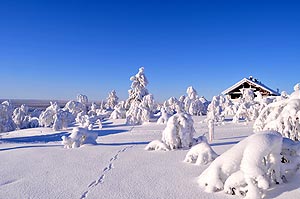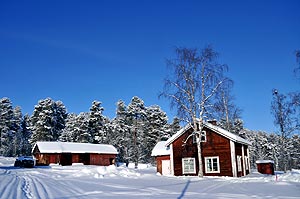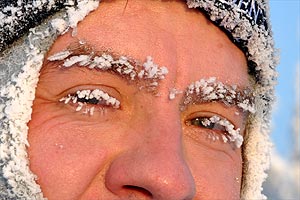|
LEM291 DXpedition Report
February 26 –
March 6, 2010
by Mika
Mäkeläinen
For
the first time I combined a family winter vacation
with DXing. We shared a cabin with Jim Solatie's
family in the Saariselkä ski resort in Lapland,
and after a freezing but fun week I and Jim drove
to Lemmenjoki for the last DXpedition of the season.
During the first week skiing was limited because
of temperatures hovering around -20 to -30 degrees,
but fortunately on the following week the AM band
turned out to be hot. This combo vacation was a
success, as we got a bunch of new stations, and
our wives have not divorced us, at least not yet.

The southern slope of
Mount Kaunispää in Saariselkä,
close to our rental cottage. |
On Friday, February
26, I drove my family from Saariselkä to Rovaniemi
to catch an overnight train home south. Finland's
national railroad company VR made history by departing
and arriving on time despite the snow and ice.
I shopped for groceries and headed
back above the Arctic Circle, which runs just north
of Rovaniemi. The roads were unusually quiet, probably
because most people were home watching the Olympic
ice-hockey semi-finals. Finland suffered a colossal
loss to the U.S. in Vancouver, so I certainly didn't
miss anything while driving in crisp -30 degree
weather to Lemmenjoki.

Kiilopää mountain
in Saariselkä in the distance |
The cabin was already stocked
with receivers and all the rest. I had visited Lemmenjoki
with Jim briefly on Monday, February 22, to leave
some automated recordings. They worked only partially,
and the conditions were not stunning, so we don't
expect any historic discoveries from those Perseus
files. However, as soon as I arrived on Friday evening,
the AM band was full of North American stations,
so I slept only for two hours during the first euphoric
night. Jim joined me on Sunday afternoon after his
family had flown south from the Ivalo Airport.
Propagation conditions during
our week turned out to be good, but very different
from what we had expected. We were hoping to hear
some stations from Australia and New Zealand, maybe
also from Thailand and the rest of South East Asia.
On the western front, this time of the year should
have been good for instance for targeting Peru.

Ice-covered trees near
the top of Mount Kaunispää in Saariselkä |
Eventually we probably got nothing
new from Australia or New Zealand, but enjoyed good
conditions to China for hours every day, as well
as moderate to good conditions to Japan in the early
afternoons. To the west, U.S. stations were heard
pretty well every day, and also on several nights,
with a bunch of Mexicans, often heard for many hours
after sunrise. All in all, conditions favored higher
latitudes than expected. There were no spectacular
historic openings to any particular direction, but
steady average or above average conditions guaranteed
a huge amount of recordings, which should yield
also nice surprises.
Here is a summary of the solar
weather indices during our time in Lemmenjoki:
| Date |
Solar
flux |
Sunspot
number |
Planetary
A index |
K
indices
(3-hour intervals) |
Min-max
solar wind speed (km/sec) |
Number
of flares (events) |
| STAR |
NO
AA |
STAR |
NO
AA |
Daily
low- high |
Planetary |
Boulder |
C |
M |
X |
| 22.2.2010 |
83.7 |
15 |
14 |
4.1 |
4 |
0-6 |
11011112 |
11121211 |
314-369 |
|
|
|
| 23.2.2010 |
84.2 |
42 |
31 |
1.8 |
2 |
0-6 |
21000010 |
22110210 |
298-358 |
|
|
|
| 24.2.2010 |
82.6 |
31 |
40 |
3.0 |
3 |
0-12 |
13000101 |
13011100 |
307-353 |
|
|
|
| 25.2.2010 |
82.7 |
28 |
30 |
2.1 |
2 |
0-7 |
10000012 |
10110112 |
314-384 |
|
|
|
| 26.2.2010 |
80.5 |
23 |
26 |
1.9 |
2 |
0-5 |
10000001 |
20000010 |
296-373 |
|
|
|
| 27.2.2010 |
78.6 |
11 |
26 |
1.8 |
2 |
0-4 |
00000111 |
10001100 |
285-314 |
|
|
|
| 28.2.2010 |
78.1 |
11 |
13 |
2.3 |
2 |
0-4 |
00101101 |
02011211 |
285-335 |
|
|
|
| 1.3.2010 |
79.3 |
37 |
36 |
5.3 |
5 |
3-7 |
11112212 |
22112321 |
297-379 |
|
|
|
| 2.3.2010 |
79.4 |
37 |
39 |
4.1 |
4 |
0-7 |
00022212 |
10022212 |
339-386 |
|
|
|
| 3.3.2010 |
80.4 |
37 |
39 |
5.9 |
6 |
0-9 |
12022222 |
22122322 |
355-421 |
|
|
|
| 4.3.2010 |
81.3 |
38 |
40 |
6.3 |
6 |
0-15 |
23202111 |
13202201 |
334-441 |
1 |
|
|
| 5.3.2010 |
79.5 |
0 |
35 |
2.5 |
2 |
0-5 |
00111101 |
00222211 |
350-404 |
|
|
|
| 6.3.2010 |
78.3 |
22 |
0 |
3.3 |
3 |
0-9 |
20001111 |
20101102 |
321-377 |
|
|
|
| 7.3.2010 |
76.6 |
12 |
0 |
4.3 |
4 |
0-12 |
23200001 |
22300000 |
346-424 |
|
|
|
(information
collected by Jan Alvestad)
What was remarkable is that in
the afternoon Far Eastern AM stations began to appear
as early as four to five hours before sunset, and
in the morning U.S. stations continued to be heard
up to six hours after sunrise in Lemmenjoki. Oh,
the joy of solar minimum... It will be interesting
to compare the times in our logs to this table of
local sunrise and sunset times:
| Date |
Sunrise
in Lemmenjoki |
Sunset
in Lemmenjoki |
| local
|
UTC |
local
|
UTC |
| 22.2.2010 |
8:10
|
0610
|
16:54
|
1454
|
| 23.2.2010 |
8:05
|
0605
|
16:58
|
1458
|
| 24.2.2010 |
8:01
|
0601
|
17:02
|
1502
|
| 25.2.2010 |
7:57
|
0557
|
17:06
|
1506
|
| 26.2.2010 |
7:52
|
0552
|
17:10
|
1510
|
| 27.2.2010 |
7:48
|
0548
|
17:14
|
1514
|
| 28.2.2010 |
7:44
|
0544
|
17:18
|
1518
|
| 1.3.2010 |
7:39
|
0539
|
17:22
|
1522
|
| 2.3.2010 |
7:35
|
0535
|
17:26
|
1526
|
| 3.3.2010 |
7:31
|
0531
|
17:29
|
1529
|
| 4.3.2010 |
7:27
|
0527
|
17:33
|
1533
|
| 5.3.2010 |
7:22
|
0522
|
17:37
|
1537
|
| 6.3.2010 |
7:18
|
0518
|
17:41
|
1541
|
| 7.3.2010 |
7:14
|
0514
|
17:45
|
1545
|
In our series of close encounters
with the Arctic wildlife, we saw more reindeer around
the cabin than ever before. It turned out that one
of the local reindeer owners' associations was moving
its herds to higher grounds through this area, and
so reindeer were passing our cottage almost daily.
This time of the year the reindeer are beginning
to leave their winter feeding areas, heading up
to the fells, where snow is exposed to the sun and
melts faster - making it easier to find lichen on
the Arctic tundra.

Reindeer on ice close
to our cabin |
Also, some reindeer had been
domesticated by the neighboring households, and
although they are free to roam around, they always
return home, where food is more plentiful than in
nature during this exceptionally harsh winter.
We also got a taste of Lapland,
quite literally. Our neighbor Aslak - who has a
very traditional Lappish first name - kindly gave
us some freshly cut and frozen reindeer meat, with
hair and all, from his snowmobile loaded with pieces
of a butchered reindeer. Reindeer meat is the basic
staple of the region, and a valued delicacy in all
of Finland.

Rudolph the red-boned
reindeer |
As our cooking expertise is limited
to heating "Kitchen Joy's" Thai meals
in a microwave oven, we wondered how on earth are
we going to prepare these chunks of meat into a
culinary treat. Eventually we decided to boil them,
as game meat may not be very tender. Obviously we
didn't boil them long enough, as the meat was still
rather tough for my taste, and Jim wouldn't even
dare to take a single bite. For the record, I survived
without any stomach ailments. Reindeer meat does
have its unique taste, which is definitely worth
trying if you ever get a chance - and a cook more
experienced than me.
Let's focus again on the essential...
This was not a culinary adventure, but an expedition
to discover something new on the AM dial. Most of
Lemmenjoki's dozen or so Beverage and longwire antennas
were used at some point, although clearly the best
antennas were a wire pointing to the Northwest at
319 degrees, and another pointing to the East at
55 degrees, used for Asian stations.

DXing headquarters of the North |
Around 2200-2300 UTC we hunted
for U.S. daytimers, and after that we tried to figure
out which trans-Atlantic region the overnight conditions
would favor, to leave automated Perseus recordings
for the top-of-the-hour slots. In the morning we
woke up before sunrise, and usually enjoyed good
reception from the Western Hemisphere until around
midday. In the afternoon, it was all Asians until
about 6 p.m. local time. Here is a more detailed
look at the reception conditions on each day:
Saturday, February 27, 2010
I got my stuff organized after
2100 UTC on Friday evening, which was a perfect
timing. After 2130 UTC several U.S. East Coast stations
emerged with decent signal strength and continued
for 14 hours. Although the end of February isn't
ideal for hunting daytimers, several daytime stations
were noted. Among the best catches early evening
were WDER Derry NH on 1320 kHz, WEZS Laconia NH
on 1350 kHz and WIZZ Greenfield MA on 1520 kHz.
KGOW Bellaire TX on 1559.937 kHz stayed on full
power through the night. There were a few scattered
Latin Americans overnight, including a fair opening
to Venezuela around 0245 UTC. Morning goodies included
XEIB Caborca SO on 1170 kHz, along with the more
common XEUVA. In the afternoon, the first Far Eastern
stations overcame static before 1100 UTC, after
which Chinese stations dominated the Asian scene
for hours. No sign of the coveted Aussies or Kiwis.

Mika Mäkeläinen |
Sunday, February 28, 2010
On Saturday evening trans-Atlantic
signals arrived later and weaker than on the previous
night, and reception improved a bit only after solid
darkness fell over the East Coast. However, conditions
to all directions remained poor, and nothing worth
mentioning was heard. As a sign of desperation I
even ventured to the 60 meter shortwave band, where
common South American stations were heard fairly
well. In the morning XETOT Tampico TM 1190 kHz rose
on top of the pile at midnight local time for full
station identifications and the Mexican national
anthem. After daybreak a selection of North American
stations tilted towards the West Coast. Asians,
led by the Japanese and northeastern Chinese, appeared
already after 1000 UTC, which is remarkably early
this time of the year. For example, from Heilongjiang
two thirds of the signal's path to Finland was in
bright daylight! Japanese stations were booming,
and the NHK1 regional break at 1255 UTC yielded
some very nice catches, including JOQC Fukaura on
1584 kHz. Later in the evening, WTWW Lebanon TN,
a new shortwave station, was heard strong and steady
on 9480 kHz, making its first appearance here.

Jim Solatie |
Monday, March 1, 2010
Trans-Atlantic reception was
poor through the night, but even after all signals
seemed to disappear in the morning, there was a
nice opening to Venezuela and the U.S. East Coast
at around 0630-0830 UTC, after which the AM band
became mostly silent. Spanish stations were also
heard with local and regional breaks around 0600-0700
UTC. A second fairly new shortwave station made
its debut in Finland around midday as Voz Missionária
from Brazil was heard on 11749.869 kHz in the 25-meter-band.
Japanese and Chinese stations emerged forcefully
around 1115 UTC and dominated the band for hours.

Digita's antennas on top
of Mount Kaunispää |
Tuesday, March 2, 2010
Despite high expectations, again
no daytimer activity on Monday evening. Initially
overnight conditions seemed poor, but conditions
improved towards the morning, and around daybreak
North American stations were stronger than on any
previous day. Also stations from the lower end of
the dial were heard, including a bunch of the most
regular Cubans. Our catches include WQAM Miami FL
on 560 kHz and Radio Ciudad Habana on 980 kHz. Stations
from Coast to Coast were heard, and because of the
sheer amount of stations, especially graveyard channels
degenerated into noisy CBC-dominated frequencies.
U.S. stations prevailed until around 1100 UTC, which
is almost six hours after sunrise in Lemmenjoki.
That's also when the first Asian stations began
their typical five-hour onslaught, first it was
the Japanese, and later on stations from further
south along the Pacific Rim - though unfortunately
not all the way to "down under".

The entire AM band on Perseus |
Wednesday, March 3, 2010
Brazilian stations were the first
to cross the Atlantic around 2100 UTC, later joined
by stations from Argentina and Uruguay, all going
relatively strong through the night. After "A
Voz do Brasil" ended at 2300 UTC on Tuesday,
we identified for example Rádio Camboriú,
Balneário Camboriú SC on 1290 kHz
and Rádio Frequencia, Garopaba SC on 1380
kHz. There were only sporadic signs of North American
stations. In the morning all trans-Atlantic stations
vanished soon after sunrise, around 0530 UTC. A
handful of Venezuelan and U.S. East Coast stations
reappeared at 0700 UTC. A narrow slice of the East
Coast was audible, allowing for example the reception
of WNBF Binghamton NY on 1290 kHz. Just before 0900
UTC the propagation path jumped to the Pacific Northwest,
and we got a nice opening to Oregon and Nevada around
1000 UTC with stations like KBZZ Sparks 1270 kHz
and KWNA Winnemucca 1400 kHz. Asian stations began
fading in gradually around 1300 UTC, much later
than on previous days. The emphasis was on lower
latitudes than before, including a few Philippine
stations logged after 1400 UTC. From China we identified
for instance Tangshan PBS on 684 kHz and Qingdao
PBS on 819 kHz.

Magical forest at dusk
in Saariselkä |
Thursday, March 4, 2010
This was probably overall the
poorest day this far. Brazilian stations began to
invade our dials after 2130 UTC and continued rather
well through the night, though not quite as strong
as on the previous night. Hardly any North American
stations were heard overnight and very few in the
morning. After sunrise all trans-Atlantic signals
vanished, but fortunately at least British and Spanish
stations were exceptionally strong. There was a
long daytime lull without anything to listen to,
until Asian signals started pouring in after 1230
UTC. Initially there were a lot of Japanese stations,
then very strong signals from China for a moment,
and by 1500 UTC also some Indian and Pakistani stations,
which had been almost completely absent on previous
days. By 1600 UTC Iranian and Arabic stations had
become dominant - along with Europeans, naturally.

Freezing, but at least it is sunny |
Friday, March 5, 2010
On Thursday evening conditions
to Brazil began even earlier than before, around
2115 UTC, just as the sun was setting in northeastern
Brazil. The first U.S. East Coast stations were
heard around 2345 UTC. Initially reception was better
from southern latitudes, but by early morning U.S.
stations improved, and we had a good opening to
Mexico at 0730-0900 UTC, including XERLA Santa Rosalía
BS on 940 kHz and KEYS Corpus Christi TX on 1440
kHz. The best part of the propagation this morning
was that stations kept changing, so we hope to find
more than the usual suspects in our recordings.
Graveyard channels were once again open fairly well.
In the afternoon the first Asians appeared around
1130 UTC, disappeared after 1300 UTC and re-emerged
by 1400 UTC. Reception was more sporadic than before,
and we heard many of the most common Philippinos
with huge signals around 1500 UTC. Soon after that
stations from the Middle East and Europe took over.
Changzhou
People's Broadcasting Station on 747 kHz
Changzhou Radio was logged on March 10th,
2010, one of the top catches of the automated
recordings left in Lemmenjoki. Changzhou
was also one of the last identified stations
that I found almost two years after the
DXpedition. My Taiwanese friend Jeff Ting
eventually identified the station. Despite
the delay between hearing the station
and reporting it, my reception report
to the station in February 2012 made headlines
all around China. For the signal to travel
7,000 kilometers to Finland was regarded
as quite exceptional. One of the first
papers to publish news about it was yzwb.net
(Yangtse.com), and it was picked up by
dozens of newspapers in China, as well
as Xinhua news agency and numerous postings
on Sina Weibo (Chinese Twitter). Thanks
to the publicity, I got several emails
from ordinary people from all around China.
Hopefully a few more Chinese now know
what DXing is all about. |
|
Saturday, March 6, 2010
No daytimers were spotted in
the early evening, and results from overnight depend
on whatever happened to get caught in our recordings,
as we desperately needed to get some sleep before
driving home. Jim left already after 6 a.m. local
time to catch a train south, while I stayed until
past midday, for as long as U.S. stations continued
to be heard. I then drove down close to Oulu, staying
overnight at Jari Ruohomäki's cabin in Muhos,
once again doing some DXing around sunrise, before
finally driving south on Sunday. We also left some
automated recordings in Lemmenjoki to capture new
Asian stations using the Beverage antenna pointing
at 55 degrees for the upcoming few weeks, as ours
was the last DXpedition of the season.
This was a fairly successful
and extensive DXpedition, so I would guess that
the LEM291 DXpedition log
will not be ready for publication until some time
in 2011 (edit: turned out to be 2012).
Published
on March 11, 2010 (slightly edited later)
  
|